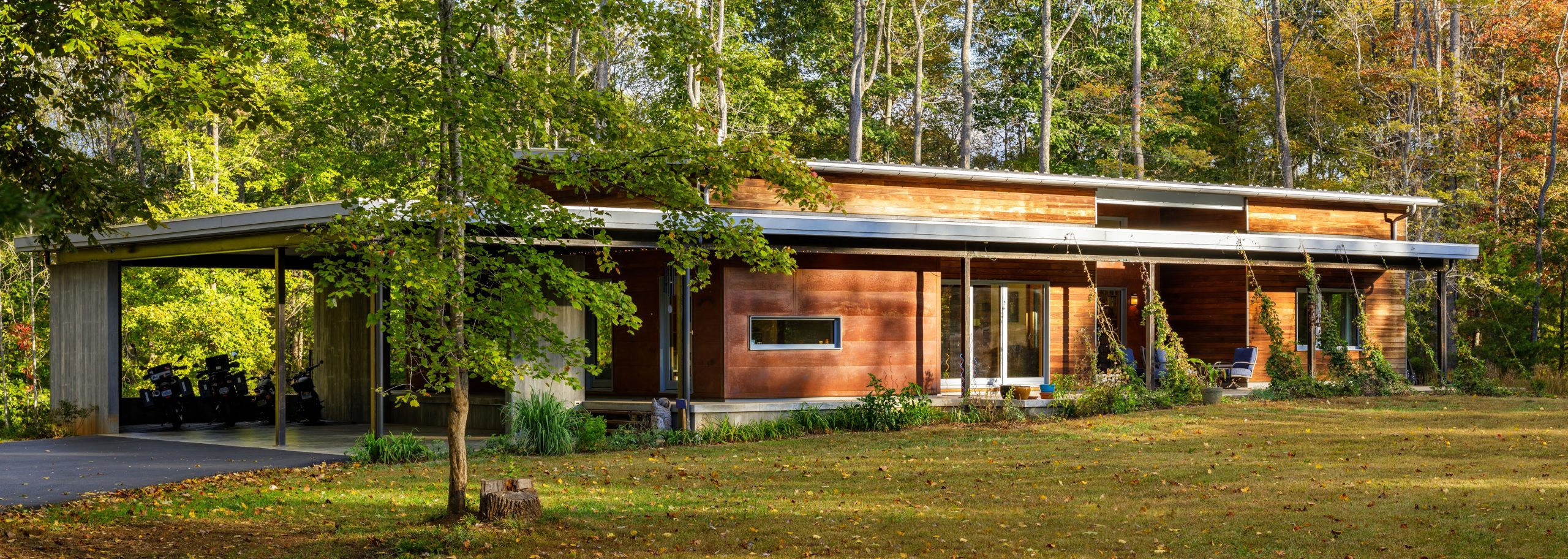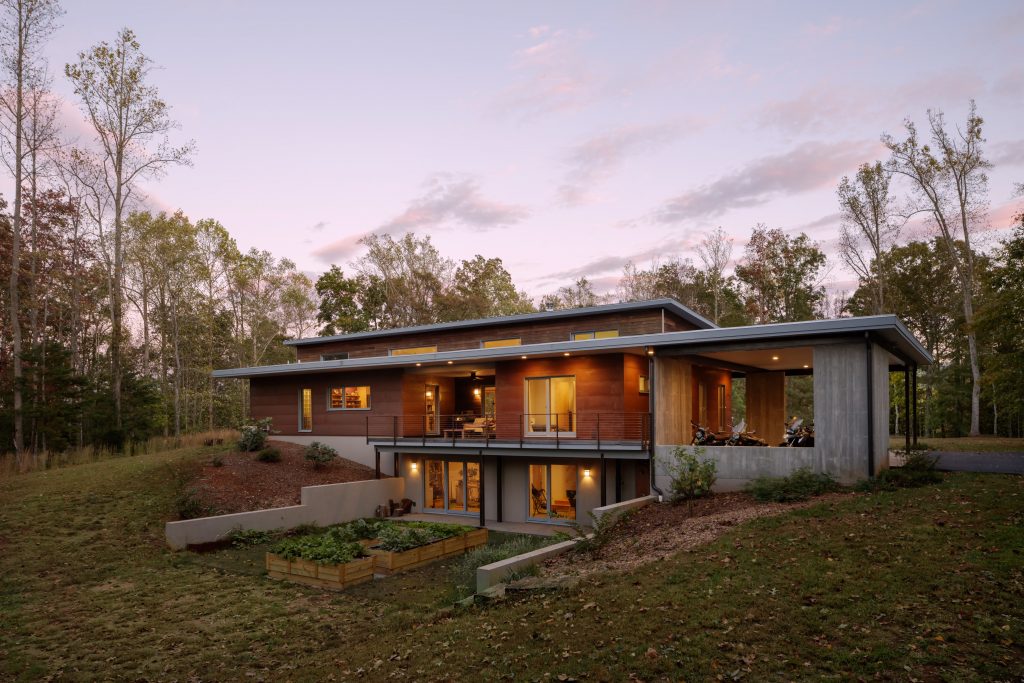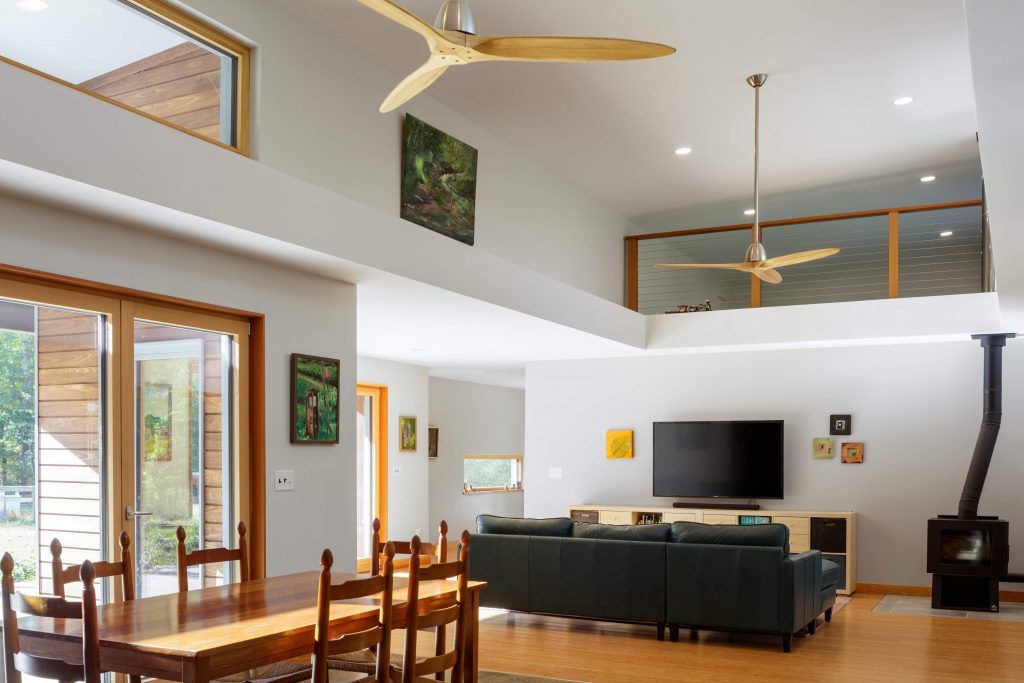
The Charlottesville-Virginia based firm Gehrung + Graham specializes in the design of net-zero and net-positive architecture. These high-performance buildings harness and produce at least as much energy as they require over the course of a year. Familiar with Passive House architecture and committed to lowering their energy footprint, the clients of the Batesville Residence approached Gehrung + Graham in 2013 to design their future home. They envisioned a comfortable, durable, low-maintenance, and energy-efficient house that offered a modern, warm and flowing interior with easy access to the copious garden and play space, and panoramic views of the surrounding Blue Ridge Mountains. Using an integrative team approach for design and construction, the Batesville Residence was able to achieve all of this and more: it has been outperforming its simulated energy demand since its completion in 2016.
Rooted in the research of the Rocky Mountain Institute and the Canadian Super-Insulated Homes of the 1970s, Passive House was developed into a building performance standard in Germany in 1991. In the mid-2000s, it gathered momentum in the United States when the Passive House Institute U.S. (PHIUS) was established.
PHIUS began training professionals and eventually adapted the design criteria and standard for the U.S. climate zones. The firm’s founding partners Barbara Gehrung and Mark Graham were exposed to the Passive House Standard during education and work in Germany and Switzerland, and were early adopters of high-performance architecture when they entered professional practice in the U.S.

Over years, the principles of Passive House design have provided the firm with a set of benchmarks that effectively guide projects of all sizes towards energy self-sufficiency. These buildings require a lower amount of energy to function in the first place than traditional buildings, making it that much easier to meet the demand with active and alternative energy sources. New research is proving that Passive House offers the most effective set of standards available for the design of net-zero energy buildings. These include:
- Conscious building orientation and size and location of windows and doors;
- An airtight building envelope that creates a barrier between indoor conditioned space and outdoor non-conditioned air in order reduce energy losses, eliminate discomfort from drafts, and ensure durability by preventing moisture problems;
- Continuous insulation of the entire envelope to resist outdoor fluctuations and maintain consistent indoor temperatures;
- High-performance windows and doors that allow for natural light without compromising the energy-performance and airtightness of the building envelope;
- Energy-efficient lighting and appliances in order to meet energy targets;
- High-performance ventilation systems (ERVs and HRVs) that are appropriately-specified to conserve energy while improving indoor air quality;
- Lowered reliance on mechanical systems by architectural means such as the use of materials that trap and release heat slowly in order to regulate indoor temperature, orienting the building and placing overhangs to increase sun exposure in some areas and reduce it in others, specifying windows that control how much infrared radiation from the sun is able to penetrate inside, and careful attention to external and seasonal shading; and
- A well-designed photovoltaic system to collect solar energy for use in the building and if possible, charge an electric car or store that energy in a battery system.
Following these guidelines, the design for the Batesville Net-Zero Residence includes overhangs on three sides to provide protection from weather and shading in the summer, large windows in the south to allow for solar heat gain in the winter, and low and high windows in the north to provide passive cooling and glare-free daylight while supporting cross-ventilation and framing views to the Blue Ridge. Because the clients preferred an orientation towards the mountains along with a low-sloping roof to nestle the house into the site, the designers decided to place the solar array away from the house. The array is manually adjusted each season so that the panel can be angled to optimize production through the year and is sized to produce as much electricity as the house and its inhabitants consume. Since it is a grid-tied system, it supplies the electric grid with surplus production and draws back from the grid at night.
Overall heating and cooling demands are minimized by the highly-insulated building envelope, which includes the use of high-performance triple-pane glass windows and doors sourced from Zola Windows — a Colorado-based company that manufactures high-quality Passive House windows in Poland.
Other built-in measures include insulated, exposed concrete floors in the basement and first floor that act as thermal mass to regulate temperatures. Remaining demands and common comforts are ensured by an electric heat-pump hot water heater and heating and cooling from two ducted mini-split heat pumps. A wood stove with direct air-supply and a sealed combustion chamber to preserve indoor air quality gives the warmth of a fire on a winter evening.

The structure of the house can be described as enhanced standard residential construction. Below ground walls are insulated concrete forms, while above-ground walls are 2×6 timber frame with 2” of rigid mineral wool insulation over a prototype of 475’s Mento Adhero Weather-Resistive Air Barrier Membrane. Unlike traditional house wrap, high-performance membrane products in combination with specifically formulated tapes function both as water-proofing and as an air-barrier. Similar to Gore-Tex for outerwear, these layers come in different degrees of permeability. In the mixed-humid climate of Virginia, highly insulated walls should be air-tight, but open to vapor diffusion to allow seasonal drying should there be any excess moisture. For the exterior, the clients chose a mixture of thermally-treated wood and weathering steel, contrasting with the exposed concrete and stucco of the basement and carport.
With its stringent performance goals, Passive House inspires a highly-collaborative and integrated team. Each team member — architect, client, consultant, contractor, and tradesperson — provides valuable perspective at every phase of the project. Gehrung + Graham worked with a network of skilled local professionals who were familiar with Passive House on the Batesville project, including our builder Daniel Ernst of Promethean Homes, energy rater and mechanical system specifier John Semmelhack of Think Little Inc., and solar installer Randy Peltola of Genesis Home Energy. They found that in the team, even those who had not been exposed to Passive House, were curious and open to learning more.
Two years after the completion of the Batesville Net-Zero Residence, the owners reported some exciting news: in addition to achieving a net-zero standard by meeting all of the home’s energy needs, they shared that it has been able to harness a surplus, resulting in a building that is actually net-positive. This surplus can be fed back into the local grid or used to power a backup energy source to keep basic mechanical systems running in the event of power loss.
“There aren’t any actions that we have to take to minimize our energy consumption,” the owner noted, “it is built into the design and construction of the house and it just flows from there.” We couldn’t explain the beauty of Passive House any better.
Team and Trades
- Architecture & Passive House Design: Barbara Gehrung, AIA International Associate, bg design & consulting, Charlottesville, VA (now Gehrung + Graham)
- Design Consulting from Mark Graham, AIA, Liminal Architecture (now Gehrung + Graham)
- General Contractor & Daniel Ernst, Promethean Homes, Steeles Tavern, Va.
- Energy Rating & HVAC Specs: John Semmelhack, Think Little, Charlottesville, Va.
- Site Work: Arnold Excavation and Hauling, Batesville, Va.
- Concrete Flatwork: Manny Herring, Scottsville, Va.
- Cavity Insulation: Weatherseal Insulation Company, Charlottesville, Va.
- Electric Installation: Dave Brooks Electric, Mint Spring, Va.
- HVAC Installation: Charlottesville Heating & Air, Scottsville, Va.
- Plumbing: Hord’s Plumbing and Backhoe, Ruckersville, Va.
- Roofing: Martin Roofing, Charlottesville, Va.
- PV System Design & Installation: Randall Peltola, Genesis Home & Energy, Waynesboro, Va.
Awards
Virginia Energy Efficiency Leadership Awards 2018, First Place
